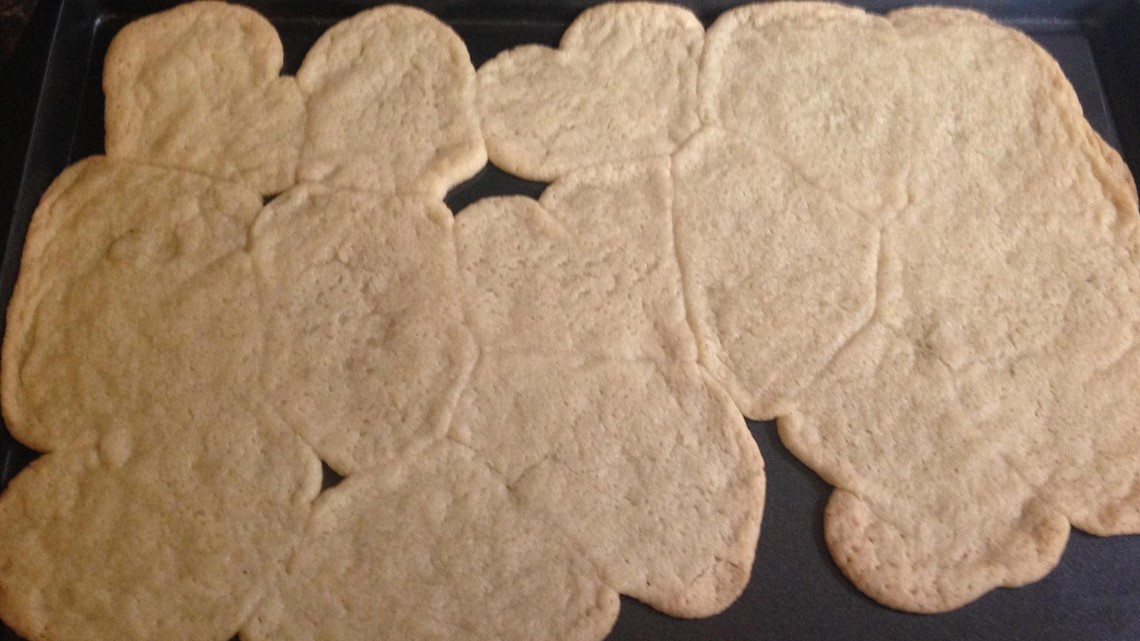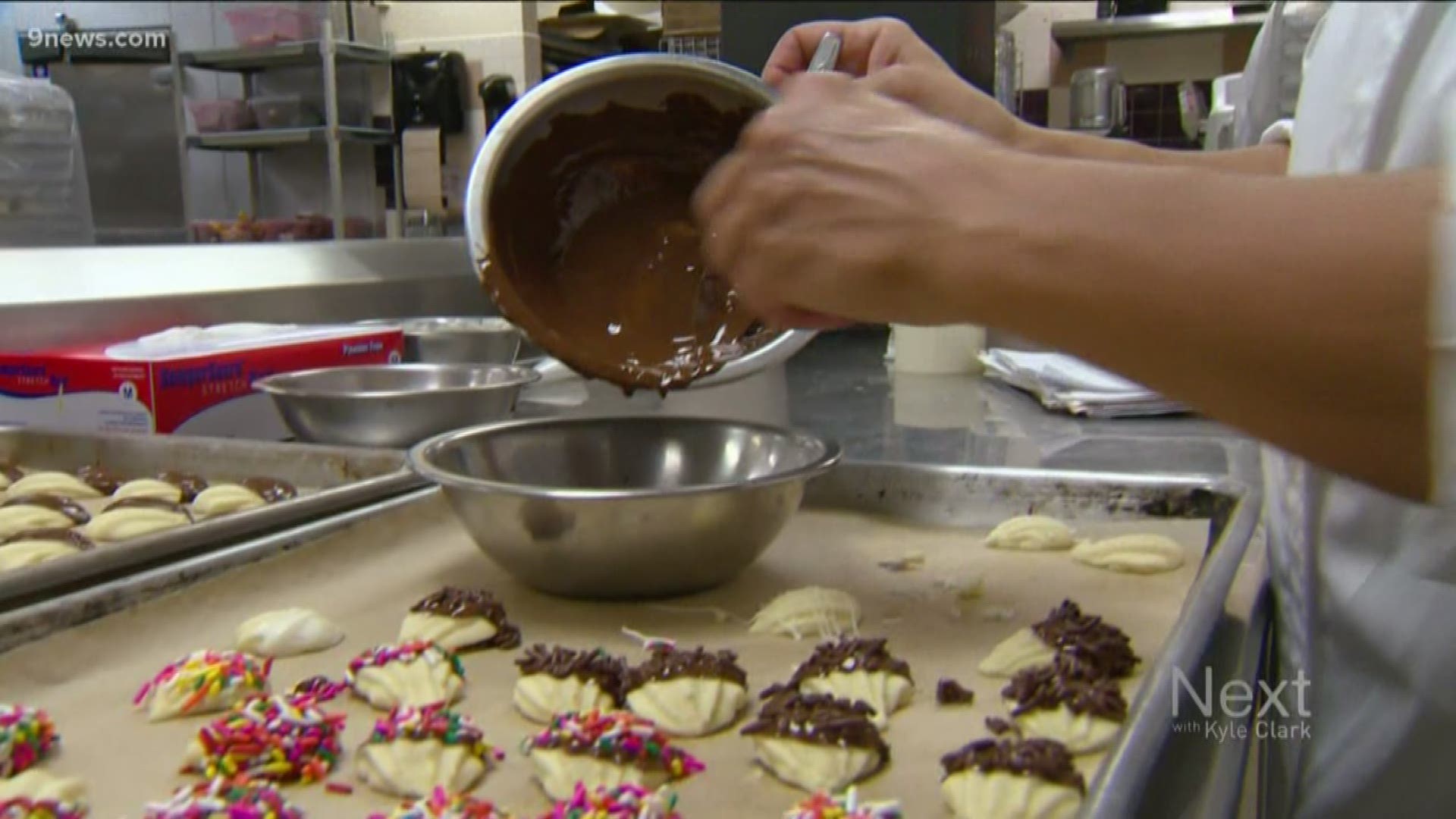DENVER — Frustration? Sadness? Anger? Defeat? There is another way, Colorado.
Baking at altitude doesn't have to be like this:


Just say no to baking while high -- without the right mix of ingredients.
"When you get here to Denver, you have to change things from the way your grandmother did them on the East Coast because of the altitude," said Marcia Kramer, who teaches at Johnson and Wales University's Denver campus.
Kramer is an associate professor at the school's College of Culinary Arts, and as evidenced by the spread of muffins, cookies and cakes surrounding her during our interview, she specializes in baking drool-inducing pastries.
Kramer spent her the Thanksgiving weekend like so many people did, by preparing homemade treats to hand out as gifts over the holidays. But unlike so many of us (I know I'm not the only one making accidental sugar cookie pizza crust), she knows how to bake properly at 5,280 feet above sea level.
"It’s harder to breathe here because there’s less oxygen available to you, and people from the East Coast come here and struggle," she said. "The pastries come here and struggle, as well, so you have to modify them."
Kramer provided us a list of tips to keep in mind, so that you may one day compete on The Great British Bake Off, or at least make a decent batch of cookies before showing up at your in-laws' house on Christmas Day.
- Heat your oven to the temperature suggested in the recipe. Changes aren't really necessary here.
- You can also expect baking time to remain about the same.
- Eggs can be beaten to the same consistency at altitude, as well.
- The way your bread rises is mostly affected by the temperature of where you leave it to rest. Kramer told us: Always use a warm spot around 85-95° F. The pilot light in the oven is usually enough heat, or you can turn on the oven for a few minutes, then open the door. Check with a thermometer. Not too much above 138°, or the yeast will die.
- Not all recipes need to be adjusted at a higher elevation, only ones with a leavener, an ingredient that helps the baked good rise, like baking powder or baking soda. Here are suggested adjustments:
- Colorado's climate is dry, so you'll need to increase liquids and eggs by 10 to 15 percent. That could mean substituting extra large eggs for large eggs. For each cup of liquid the recipe calls for, add 1-2 tablespoons of more liquid. Water is always a safe bet, as it will not affect flavor, or user the liquid present in the recipe.
- If you don't have extra large eggs, you can take 10 percent more from a large one by whisking it. Then take out a tablespoon.
- Increase flour by 4 percent (another 1-2 tablespoons per cup in the recipe).
- Decrease sugar by 6 percent (1-2 tablespoons per cup in the recipe).
- Decrease chemical leavener, the baking soda or baking powder, by about half. Kramer told us: This one is the most important, as it is what causes the reaction in the oven. You can see an off-green color or no spread when using too much leavener. Also, you will get a salty aftertaste from the sodium in those products.
- If you buy premade cookie dough from the store, you can't change the ingredients. Test it in small batches. If the temperature gets too hot too fast, it could cause the cookies to rise and collapse. If it's too low, they'll be too flat and spread too much (as demonstrated above). It all depends on your oven, Kramer said. Convection can have too much wind and cause problems, so conventional may be the better choice.
- These suggested adjustments are for Denver's elevation. Recipes might need more changes if you're in Vail, for example.
Colorado State University also posted this brochure online. It offers specific adjustments for different recipes.
Kramer passed along some of her favorite holiday recipes to go with her tips. Happy baking!
BISCOTTI
Butter, room temperature 8 oz (2 sticks)
Sugar, granulated 1 1/3 cups
Lemon zest (use a microplane)
Eggs, 4 large
Pastry flour, 4 ¼ cups
Baking powder, 2 tsp
Salt, ½ tsp
Vanilla (or our favorite extract), 1 tsp
Chips (your favorite type) 1 ½ cups
Nuts (your favorite type) 1 cup
For high altitude, change sugar to 1 ¼ cups, flour to 4 ½ cups, baking powder to 1 tsp, and egg to extra large.
Mixing directions:
Cream butter and sugar with an electric mixer. Mix until fluffy. Do not overmix or cookies will fall.
Whisk eggs lightly to break up yolks.
Add eggs gradually (1/3 at a time). Scrape between additions.
Add vanilla.
Sift dry ingredients together and add dry ingredients on low speed 1/3 at a time.
Toss nuts and chips with last third of the flour. Stir in by hand with a wooden spoon.
Dust counter lightly with flour. Split the dough into 3 logs. Roll gently and lightly in flour until the length of the cookie sheet. Use only as much flour as needed to prevent sticking. Place each log on a cookie sheet and press gently down the entire length to flatten. Bake at 350° F for about 30 minutes or until golden on top, and they spring back when touched. Cool completely. Slice on bias (at an angle), lay flat and re-bake until toasted 5-10 minutes. Cool completely.
Optional: Dip in dark chocolate and stripe with white chocolate.
GINGERSNAP COOKIES
Butter at room temperature, 1 ½ sticks (6 oz/12 tbsp)
Sugar, 1 cup
Molasses, ¼ cup
Egg, 1 large
Vanilla extract, ½ tsp
AP flour, 2 cups
Baking soda, 1 ¾ tsp
Cinnamon, ¾ tsp
Ginger, ¾ tsp
Salt, ½ tsp
Sugar in the raw, as needed for topping
Mixing directions:
Cream butter and sugar together until fluffy, about 5 minutes.
Add egg, molasses and vanilla, mix until incorporated, and scrape down.
Sift remaining dry ingredients in a separate bowl. Add dry to wet mixture in thirds, mix only until incorporated.
Split the dough into two portions and roll into a log. Wrap each log in wax paper and refrigerate until firm (minimum 3 hours).
Slice logs into scant ¼” pieces and lay onto a baking sheet. Top with raw sugar. Bake at 350° F until golden brown, about 10-15 minutes.
Note: cookies will puff up, and then flatten.
For high altitude, reduce sugar to ¾ cup and baking soda to 1 tsp.
And remember, if your recipes still don't turn out the way you hoped, we here at Next with Kyle Clark celebrate holiday failures, and laugh with you about them on TV! Email your holiday failure stories to next@9news.com.
SUGGESTED VIDEOS | Full Episodes of Next with Kyle Clark

